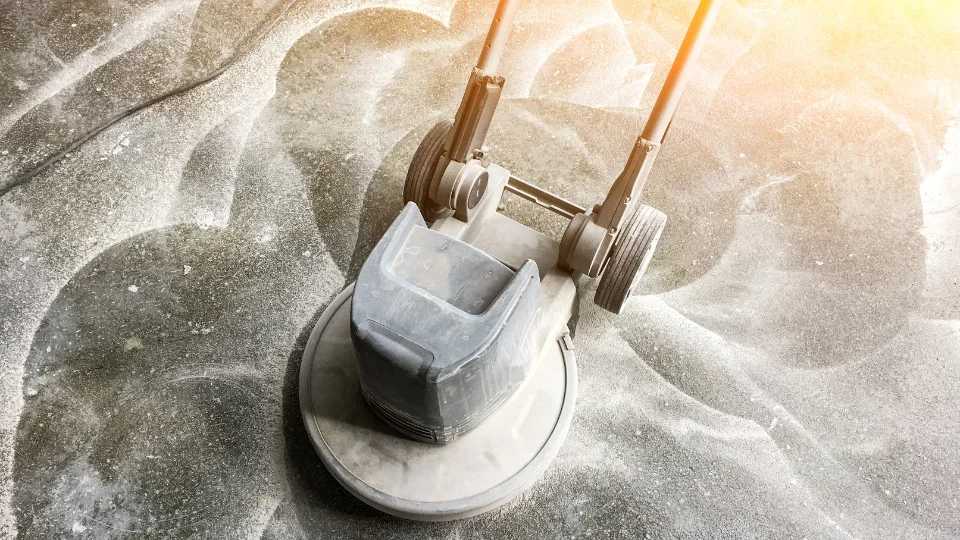Stained Polished Concrete Floors: Combining Style and Functionality
Stained polished concrete floors are becoming a popular choice among property managers who want long-term durability, modern style, and cost control in high-traffic environments. Whether you manage a retail space, office building, warehouse, or multifamily facility, this flooring system offers a smart balance between performance and design.
Unlike traditional concrete surfaces, stained polished concrete floors deliver a decorative finish that can mimic the look of stone, marble, or even wood grain. At the same time, they offer the strength and simplicity that commercial spaces demand. This blog explores how these floors work, why they make sense for commercial properties, and what to consider before installation.
What Are Stained Polished Concrete Floors?
Stained polished concrete floors start with a concrete surface that is mechanically ground, refined, and polished using industrial diamond grit tools. During or after this process, a stain is applied to add color and design effects. This stain can be reactive (acid-based) or non-reactive (water-based), depending on the look you're after and the condition of the concrete.
After staining, the concrete is sealed and polished to a high sheen or a matte finish, depending on the aesthetic goals. The result is a dense, durable, and attractive surface that resists damage from heavy foot traffic, equipment, moisture, and chemicals.
Why Property Managers Choose Stained Polished Concrete Floors
Property managers are constantly looking for flooring systems that perform well without increasing long-term maintenance costs. Here’s why stained polished concrete floors stand out:
1. Low Maintenance and Easy Cleaning
Because the surface is polished and sealed, stained polished concrete floors do not trap dust, dirt, or allergens. Routine maintenance often involves just dry mopping and occasional damp mopping. There’s no need for waxing, stripping, or recoating like other surfaces. This simplifies upkeep in busy commercial settings.
2. Long-Term Durability
Polished concrete is extremely resilient under foot and wheel traffic. It resists cracking, peeling, and chipping when properly installed and maintained. Stains used in this process penetrate the surface and won’t flake or fade quickly, even in sunlit areas or open industrial bays.
3. Customizable Aesthetic Options
Stained polished concrete floors offer dozens of customization choices. You can choose earthy tones that complement an industrial design, vibrant colors for branding, or subtle stains that resemble natural stone. Stains can be applied in layers, and stencils can add logos or directional markers directly into the slab.
This flexibility makes stained polished concrete an ideal choice in lobbies, showrooms, schools, medical offices, and high-visibility tenant spaces.
4. Cost-Effective Over Time
While the upfront cost can be slightly higher than basic concrete sealing, the return on investment becomes clear over time. Thanks to the longevity and minimal maintenance required, property managers can often offset the cost in just a few years. There’s also no need to remove and replace worn flooring every 10 to 15 years, as is common with carpet or vinyl.
5. Eco-Friendly Benefits
Polished concrete doesn’t require hazardous coatings or adhesives. Most projects use an existing slab, reducing material waste. These floors also help contribute to LEED points in green building projects. They support better indoor air quality since they don’t trap mold, allergens, or VOCs.
For property managers who value sustainability, stained polished concrete floors align with environmentally conscious practices and green building codes.
Staining Options: Acid vs Water-Based
Understanding the type of stain used can help you plan the look and lifespan of your stained polished concrete floors.
Acid-Based Stains: These react chemically with the concrete to create rich, marbled color variations. They are ideal for more artistic or organic looks. Because they penetrate deeply, acid stains tend to be permanent but offer less control over exact shades.
Water-Based Stains: These are non-reactive and offer a more predictable color range. They are available in a wider variety of hues and are easier to apply on newer concrete surfaces. Though slightly less durable than acid stains, modern sealers and topcoats provide excellent protection.
If you’re not sure which to choose, your concrete contractor can guide the selection based on the age of the slab, its exposure to sunlight, and the intended use of the space.
Where to Use Stained Polished Concrete Floors
This flooring system fits a wide range of commercial applications. Here are some common property types that benefit from it:
Retail Stores: Supports branding through color and logo integration while holding up to shopping cart and foot traffic.
Offices and Lobbies: Creates a modern and professional appearance that impresses visitors without requiring constant upkeep.
Industrial and Warehouse Spaces: Enhances light reflectivity to improve visibility, while resisting forklift and pallet wear.
Healthcare Facilities: Offers hygienic benefits and easy disinfecting in exam rooms, corridors, and common areas.
Schools and Campuses: Stands up to rolling desks, foot traffic, and regular cleaning with minimal wear.
These benefits make stained polished concrete floors a smart choice for nearly any commercial property that prioritizes long-term value and visual appeal.
Important Considerations for Property Managers
Before committing to stained polished concrete floors, there are a few factors property managers should evaluate:
Condition of the Existing Slab
Older concrete may have cracks, patches, or stains that can impact the final appearance. A site inspection can determine if repairs or surface prep are needed.
Moisture Levels
High moisture levels in the slab can interfere with stain adhesion and lead to discoloration. Moisture mitigation may be required before staining.
Color Expectations
Because concrete is a natural material, color can vary slightly from section to section, especially with acid stains. It’s best to view samples in person and approve mock-ups before full application.
Project Downtime
Installing stained polished concrete floors involves grinding, staining, and curing time. Most contractors will work with property managers to phase work around tenants or schedule work during off-hours to reduce disruptions.
Maintaining Stained Polished Concrete Floors
Ongoing care is simple but important. Daily dust mopping helps preserve the sheen and keeps debris from scratching the surface. Occasional damp mopping with a pH-neutral cleaner is recommended. Over time, a reapplication of sealer may be necessary to keep up the protection, especially in high-traffic areas.
Partner with McCord Contractors for Stained Polished Concrete Floors
Stained polished concrete floors give commercial properties a clean, durable surface with added style. They support property value, reduce ongoing maintenance costs, and create a high-end look without the high-end upkeep.
At McCord Contractors, we specialize in delivering professional results that meet the demands of commercial facilities. We work closely with property managers to plan projects that fit budgets, timelines, and tenant needs. From surface prep to stain application and final polishing, our team brings years of experience to every project.
Ready to upgrade your floors? Contact McCord Contractors today to learn more about our stained polished concrete floor services and get a quote for your commercial space.
Frequently Asked Questions About Stained Polished Concrete Floors
How long do stained polished concrete floors last in commercial buildings?
When properly installed and maintained, stained polished concrete floors can last 20 years or more. Their longevity makes them an ideal investment for commercial properties with high traffic. Periodic cleaning and occasional resealing help maintain the surface appearance and performance.
Are stained polished concrete floors slippery?
Stained polished concrete floors can have a smooth appearance, but they are not necessarily slippery. The level of polish and the type of sealer used affect slip resistance. For commercial buildings where safety is a concern, contractors can apply a matte finish or add a grit additive to improve traction in wet areas.
Can stained polished concrete floors be installed over existing flooring?
In most cases, the existing flooring must be removed to expose the concrete slab. Stained polished concrete floors require a clean, solid surface for grinding and staining. If your building has tile, carpet, or another covering, those layers will need to be taken out before installation begins.

